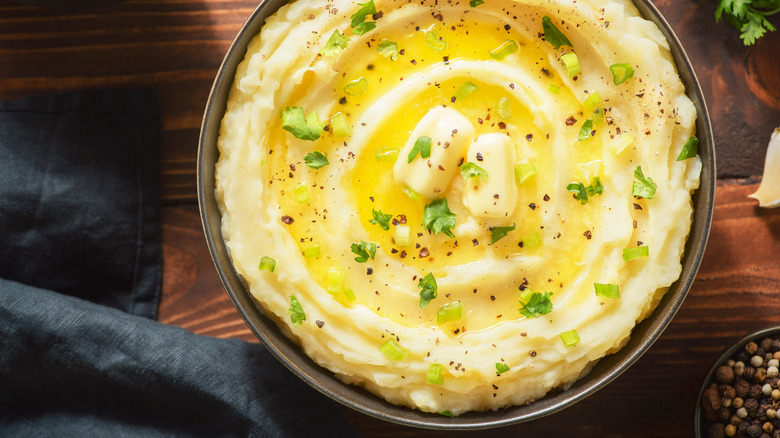Why You Should Never Make Mashed Potatoes In A Food Processor
There's nothing better than a bowlful of hot, creamy, well-seasoned, buttery mashed potatoes — they may just be the ultimate comfort food. The side dish is an integral part of many holiday meals, from Thanksgiving to Easter. (If you don't produce perfect mashed potatoes for your holiday dinner, you may have a revolt on your hands.)
To prepare the spuds, you can bake the potatoes, per Food Network, boil them, as Pillsbury suggests, cook them in your Instant Pot, steam them, or use a slow cooker. Once the potatoes are done, you can use a ricer (bonus: you won't have to peel the potatoes if you use this method), a potato masher, a food mill, beat them by hand, or use a mixer. The perfect mashed potatoes should be fluffy, creamy, rich, and smooth, with no lumps.
But there's one method you should never use: a food processor, per Food Network. But why not? The food processor makes perfect purées out of peas, carrots, and other veggies. Why are potatoes the exception?
Making the perfect mashed potatoes
When it comes to mashed potatoes, food processors are simply too powerful. With its whirring blades, a food processor will overwork potatoes, ruining the side dish. If the potatoes are overworked, too many cells are destroyed, too much starch is released, and the potatoes become gluey and sticky, explains Serious Eats. Just a few seconds too long in the appliance, and your potatoes will be better used as Silly Putty than a luscious side dish.
Bon Appétit adds that the only time your potatoes should go anywhere near a food processor is if you're looking to make a purée. In that case, the food processor's strength is a good thing.
And if your mashed potatoes do turn out gluey, you can still save them by making a Pommes Aligot recipe. That French recipe, which is a cross between mashed potatoes and fondue, is loaded with cheese and crème fraîche and is deliberately overworked so the potatoes are stretchy and, well, gluey. And it's delicious.
The science of potato starch
What are the best potatoes for making this wonderful side dish? Well, potatoes have two kinds of starch: amylose and amylopectin, according to MasterClass. Those starch molecules determine what happens when the potato is cooked. Amylose is a straight-chain starch, while amylopectin is branched, per Science Direct. High-starch potatoes have a higher proportion of amylose, so in the heat, the amylose molecules separate easily, creating a floury texture. Low-starch potatoes have more amylopectin, which is highly branched. When low-starch potatoes are cooked, the freed amylopectin tangles and holds the potato flesh together, which is why those potatoes are better for potato salad.
High-starch and medium-starch potatoes are the best mashed potato choices. When these potatoes are cooked, the cells soften, and some of the starch granules expand and burst so the flesh falls apart. The amylose mixes easily with the butter and cream and all the good things that make mashed potatoes so delicious.
The best varieties for mashed potatoes include high-starch russet and medium starch Yukon Gold. Both of those potatoes have lots of amylose, so mashed potatoes made from them will be creamy and rich. You can even combine them for great texture and the buttery flavor that Yukon Golds provide.


